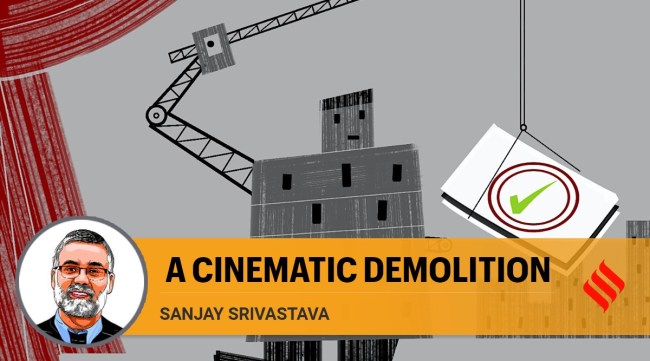Opinion Supertech buildings’ demolition is a cinematic distraction from nexus between state and builders
Sanjay Srivastava writes: It would be a tragedy if the spectacle of the Noida demolition comes to stand for how to tackle urban malaise. That requires a different approach
 Sanjay Srivastava writes: Beyond the illegality of a pair of buildings in Uttar Pradesh, lies the story of a national drama with origins in the early to mid-1980s. (Illustration: CR Sasikumar)
Sanjay Srivastava writes: Beyond the illegality of a pair of buildings in Uttar Pradesh, lies the story of a national drama with origins in the early to mid-1980s. (Illustration: CR Sasikumar) The massive and cinematic cloud of dust that enveloped the surroundings of the recently-demolished Supertech buildings in Noida is an apt metaphor of the new relations between land, private real estate players and the state. These, in turn, derive from changing aspirations on the part of different sections of the population that have fed the demand for individual dwellings across the country. As vast tracts of erstwhile rural lands are converted into gated communities promising a world of comforts, another cloistered world has also arisen. This is the largely opaque realm of kinship between the state and real estate companies. The August 28 dust-cloud in Noida neatly captures a relationship that is both opaque and also harmful to the political and social economies of a democracy. Beyond the illegality of a pair of buildings in Uttar Pradesh, lies the story of a national drama with origins in the early to mid-1980s.
In Delhi and the areas that surround it (the territory known as the National Capital Region), the market for land during the 20th century was spurred by the actions of the government. In the first half of the previous century, private developers were confronted by formidable barriers to entry. As land-holding bodies, the Delhi Improvements Trust (established 1937) and the Delhi Development Authority (1957) were effective land monopolists. Their actions led to massive inflation in land prices and locking out large sections from decent habitation infrastructure. They inhibited machinations by private players but did not, in fact, act in the public interest.
The government’s actions as a land monopolist in the Delhi region (the story varies in different parts of India) led private players to look beyond its boundaries. Areas in Haryana and UP that bordered the city emerged as important nodes of urbanisation. From the mid-1980s, with the emergence of new sources of home loans, the expansion of the middle class and rise of overseas remittance, the private housing market took hold. However, notwithstanding the seemingly formal nature of the arrangements that surround land transactions – loan documents, title deeds, acts for land acquisition and regulation of the real estate sector – land transactions remain extraordinarily informal and stubbornly damaging of the public good. Quite curiously, or perhaps predictably, different levels of the state appear to like things this way.
Since the 1980s, the history of new urbanisation in India is one of the new relationships between government mechanisms and private players where the visibility of planning methods acts as a curtain for constant post-approval alterations. This usually happened as land values increase and it became profitable to “convince” government regulatory authorities to allow changes in the plans that were actually approved — plans for schools and charitable hospitals were frequently transformed into more lucrative alternatives.
Watch | A resident in the neighbouring society shares their point of view, in a slow-motion video of the #SupertechTwinTowers demolition
Follow our blog for live updates: https://t.co/FKt3ku0m79 pic.twitter.com/6yMlVcd9kA
— The Indian Express (@IndianExpress) August 28, 2022
It was (and is) just as common that land acquired for public purpose – a road, say – became the site of a private developed gated community. And further, a road that might be shown on the map as a straight line, turns out on inspection to be made up of a series of zig-zagging stretches because that proved to be of greatest benefit to all parties to the scheme. This, of course, involves collaboration between different levels of government, politicians, real estate companies, land surveyors and brokers of different kinds. In the newly urbanising rural-urban frontiers in particular, the multiplicity of land systems, units of measurement and the fact that planning procedures follow, rather than lead, actual construction makes it almost impossible to institute mechanisms of transparency. Technological fixes are easily subverted by kin-like relations that now exist between different stakeholders in land, the most important of which is the state.
The visual impact of the Noida demolition – video clips widely relayed across social media, complete with cheering and clapping on-lookers – appears to have been interpreted as a message to the powerful “builders lobby” on behalf of a hapless but indefatigable citizenry. However, this is to miss the processes that have become established over the past few decades whereby there isn’t an easily identifiable builders lobby that acts against public interest. What we have, rather, is a state-real estate complex where it is increasingly difficult to work out where the state ends and private interests begin. This is the Indian version of the military-industrial complex. The corporatisation of the state – a process that, perhaps, those applauding the demolition might themselves approve of – that has accompanied the emergence of recent land markets makes it increasingly difficult to protect public welfare.
Keeping aside the legal aspects of the demolition, there is another danger in unequivocal celebration of the demolition for the ways in which we think of cities and urban life. For, it now becomes easier to say: “Demolish all that is illegal”. In deeply unequal cities, this can only lead to attitudes of great callousness towards the most disenfranchised of urban dwellers. As arduous the task of those who fought the case for demolition was, it is also a reminder that justice is frequently a function of the capacity to achieve it. It would be a terrible tragedy if the spectacle of the Noida demolition comes to stand for how to tackle urban malaise. This requires a different approach.
For every Noida-type demolition, our cities are witness to several well-established patterns of illegalities that, in the fitness of time, become legalised. The several enclaves of the well-off and encroachments upon forest lands by powerful people are prominent examples. This denudes urban environments and also makes for incredibly unjust cities. It is easy to blow up illegal buildings here and there but more difficult to question the peculiar relations between the governments and land markets and our own participation in it. Demolitions are spectacular events but spectacles are not the best way to make better cities.
Our relation to spectacular events as proxies for interrogating social and political structures – we cheer the fall of a building but are unwilling to question the nature of the state in whose full sight it blossomed – can only suggest that while the dust in Noida may settle in a while, the clouds will remain.
The writer teaches at the SOAS University of London


